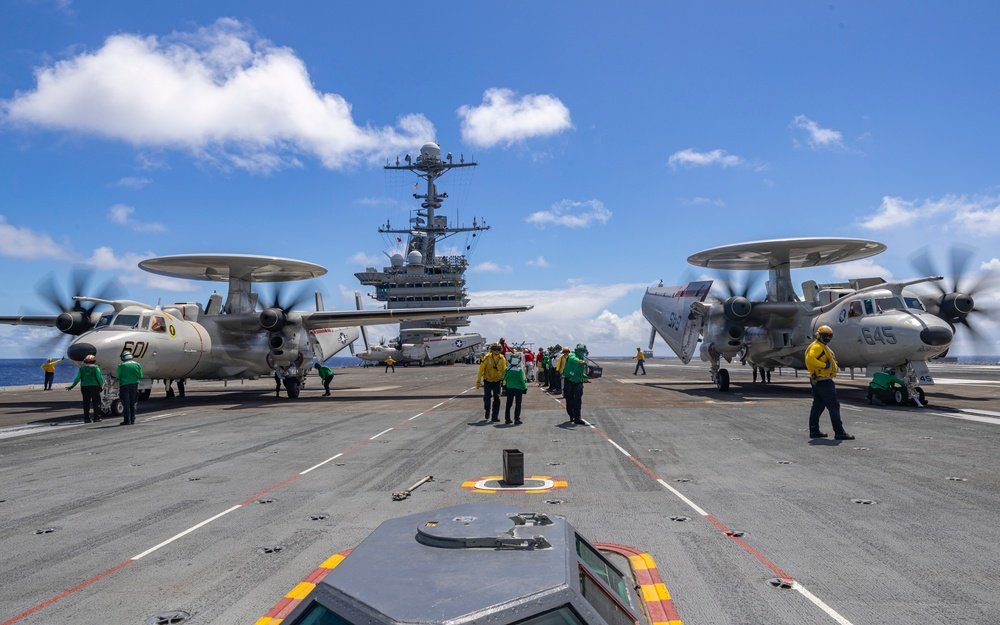Satellite imagery from western China has revealed that the People’s Liberation Army (PLA) is conducting military exercises simulating strikes on key US electronic warfare aircraft, according to a report released by private intelligence firm AllSource Analysis on February 13.
A satellite image taken in January 2025 over a desert range in Xinjiang shows two mockups resembling US Navy E-2 Hawkeye airborne warning and control aircraft.
The satellite imagery was captured by Planet Labs PBC, a commercial intelligence company. This appears to be the first documented case of the PLA utilizing E-2 Hawkeye mock-ups as simulated targets.
The E-2 Hawkeye is crucial for US naval operations, acting as an airborne early warning system and a command-and-control hub for carrier strike groups.
Often called “the airborne eyes and ears of the US Navy,” the aircraft coordinates air and naval operations, provides situational awareness, and facilitates communication between maritime and aerial forces.
The discovery of E-2 Hawkeye mockups suggests that China is prioritizing developing tactics and weaponry to disrupt US naval operations.
Unlike previous Chinese training exercises focused on attacking US fighter jets and carriers, targeting the E-2 emphasizes neutralizing critical support aircraft that play a pivotal role in battle management.
In addition to the E-2 replicas, the satellite image also revealed mockups of two aircraft carriers and one warship at the same testing site. The weapons range is known for hosting naval strike training, including simulated attacks on US carriers, warships, and moving targets.
The report said, “These new targets that first appeared in January 2025, are observed at a Chinese weapons testing range known for hosting naval targets, including US carriers, warships, and rail-based moving targets. The development of such targets suggests an effort to enhance Chinese military strike capabilities.”
“Such simulations would also enable improved target acquisition techniques, bolstering the People’s Liberation Army’s ability to engage complex military assets across land, sea, and air domains,” the report added.
China Targets US Navy’s ‘Eyes In The Sky’?
The recent discovery of E-2 Hawkeye mock-ups in China follows previous satellite imagery from last year that revealed PLA Air Force pilots training to conduct airstrikes on American F-35 and F-22 replicas in the deserts of Xinjiang.
These findings indicate a broader effort by Beijing to refine its ability to target critical US military assets, particularly those essential for air and naval dominance.
This development comes at a time when Taiwan is planning to acquire six E-2D Advanced Hawkeye aircraft, the most modern version of the airborne early warning and control platform used by the US Navy.
These new aircraft will replace Taiwan’s current fleet of five E-2K Hawkeyes to strengthen the island’s ability to detect and track potential threats in the region.
Given the PLA’s aggressive military posture toward Taiwan, the inclusion of E-2 Hawkeye mock-ups in China’s weapons testing range raises concerns that Beijing may be preparing for countermeasures against US and allied forces operating in the Indo-Pacific.

Beijing has long viewed US naval power projection as a strategic threat in the context of a possible Taiwan conflict.
The PLA has been actively working to develop counter-intervention strategies, including enhanced military simulations designed to replicate real-world combat scenarios against American forces.
The addition of the E-2 Hawkeye to these exercises signals China’s intent to refine its ability to strike high-value battlefield assets, which could play a decisive role in any future conflict in the region.
At the core of these preparations is China’s expanding arsenal of long-range strike capabilities, including ballistic and cruise missiles specifically designed to counter US naval dominance.
The DF-21D anti-ship ballistic missile, commonly referred to as a “carrier killer,” alongside an increasing number of supersonic anti-ship cruise missiles, is considered a serious challenge to US carrier strike groups.
The US Navy relies heavily on airborne early warning platforms like the E-2 Hawkeye, which offer critical over-the-horizon tracking and threat detection to counter these threats.
Despite its strategic importance, the E-2 is completely unarmed but is vital for relaying target data to fighter jets and warships, which then intercept incoming threats.
If China succeeds in disrupting or eliminating these aircraft in a conflict, US forces would be left blind to approaching threats, severely compromising their ability to respond effectively. This could tilt the balance in favor of the PLA in a heavily contested environment such as the Taiwan Strait.
- Contact the author at ashishmichel(at)gmail.com
- Follow EurAsian Times on Google News




